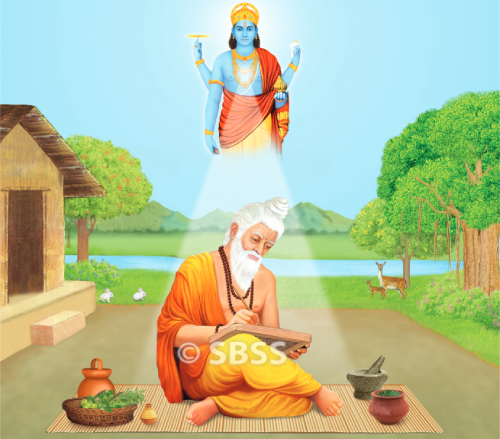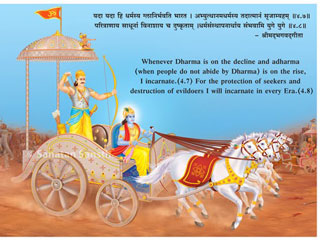Ayurveda for a healthy life ! – 22/2024

5. Kalakruta karanarni that is environmental factors (This was covered in earlier fortnight session)
The topic has discussed the matter as here –
In summer, the dry air which we breathe in continuously and with which the skin is in constant contact increases the dryness of the body. This in turn would result in increase of vata dosha in the body which also is dry. The burning heat of October that is sharad season would tend to increase the heat in the body, which in turn would result in increase of pitta dosha, which is also hot in nature. The cold atmosphere of the winter would tend to lower the body temperature, which in turn would result in increase of kapha in the body, which is cold in nature.
Time and season
Time is eternal and exerts its effects on every living creature as well as on inanimate objects. Thus every living creature after birth, grows, matures, degenerates (old age) and dies in course of time. Time is further divided into morning, afternoon, evening and night, various seasons.
Following table summarises the effect of time factor on the three doshas.
| Time when a particular dosha is dominant | Vata | Pitta | Kapha |
| Seasons | |||
| Greeshma | Chaya | Prashama | |
| Vasant | Prakopa | ||
| Varsha | Prakopa | Chaya | |
| Sharad | Prashama | Prakopa | |
| Hemant | Prashama | ||
| Shishir | Chaya | ||
| Time of day /night | 2 – 6 pm evening
2 – 6 am late night |
10 a.m. – 2 pm afternoon
10 pm – 2 am midnight |
6 -10 am morning
6 -10 pm early night |
| Relation to food | After digestion is over | During digestion | Immediately after food intake |
| Age | Old age | Youth | Childhood |
Some diseases like malaria manifest in a periodical manner. Asthmatic attacks usually occur at night. Chronic diseases like eczema, asthma, nephrotic syndrome tend to have seasonal aggravation. Old age and death represent natural disease, which no body can avoid.
Doshas and season
चयप्रकोपप्रशमा वायोग्र्रीष्मादिषु त्रिषु ।
वर्षादिषु तु पित्तस्य श्लेष्मणः शिशिरादिषु ।। – वा. सू. १२.२५
Vata, pitta and kapha are naturally increased in varsha that is monsoon, sharad, that is autumn and vasanta that is spring respectively. This natural increase is termed as prakruta dushti (natural vitiation). On the other hand, if pitta increases during winter and kapha increases during summer, it is termed as Vikrutadushti that is unnatural vitiation of dosha. Diseases arising as result of prakrutidushti are easily cured, while those arising as a result of vikrutadushti are difficult to cure.
6. Vaya : Age
Everyone passes through the stages of childhood, youth and old age marked by growth, maturity and senescence. Kapha, pitta and vata are the dominant doshas in childhood, the middle age and the closing years of life respectively. Hence kaphaja, pittaja and vataja diseases are common in children, youth and old people respectively. Children have delicate tissues and organs and poor resistance to infection and are likely to suffer from disorders of growth and development and kaphaja diseases. Adults are prone to pittaja disease like hyperacidity. Old persons are prone to vataja diseases, which include various degenerative disorders and they undergo gradual loss of functions of various organs.
7. Lingam : Sex
The morbidity and mortality in most of the diseases is generally less in females as compared to males. This may be partly explained on the basis of intermittent natural purification of the body during the menstrual period. In addition, the regenerative ability of all the tissues is increased during pregnancy and lactation.
All the body channels in the females are wider and more distensible. Hence obstructive diseases of various body channels including blood vessels, lymphatics etc. are less common in females. Hence coronary thrombosis, hemiplegia etc. are less common in females.
8. Daishika Karanani – Regional factors
Certain diseases are peculiar to and are found only in certain regions. Regions are classified as anoopa that is wet land, jangala that is dry land and sadharana that is average land.
Anoopa pradesh that is wet land is characterised by heavy rainfall, dense forest, marshy places and scanty breeze. The local inhabitants tend more towards kapha constitution and are
prone to develop kaphaja diseases that is diseases caused by dominance of kapha.
Jangala pradesh that is dry or arid land has minimum or no rain fall with dry winds blowing off and on. The local inhabitants, hence tend more towards vata constitution and are prone to develop vataja diseases.
It is important to know the place of birth of the patient
as well as the place, where he had spent his childhood and the places of origin of the disease.
9. Vyavasayika Karanani – Occupational factors
Persons following certain profession and businessmen are more prone to develop certain diseases because of the nature of
their duties.
सदाऽऽतुराः श्रोत्रियराजसेवकास्तथैव वेश्या सह पण्यजीविभिः ।
– च. सि. ११.५
That is priests usually ignore their natural urges as they
are busy with religious rituals. Royal attendants work under psychological tensions. Businessmen lack exercise because of the sedentary nature of their work. Prostitutes are prone to develop venereal diseases.
10. Indriyanam Heena, Mithya Atiyoga – Excessive, inadequate or abnormal use of sense and motor organs
Normally, the interaction between various sense organs and the environmental objects, which stimulate them is well balanced. If not, body tends to attenuate or avoid it.
The following tables gives the examples of excessive, less and abnormal interaction of various sense organs and their objects all of which give rise to diseases of that particular sense organ and later a generalised disease.
| Sense organs and sense objects | Interactions | ||
| Excessive | Less | Abnormal | |
| Hearing and sound | Hearing loud sound or hearing continuously |
Not hearing at all or hearing too infrequently | Hearing, harsh frightening, impolite, unpleasant, news suggestive of impending calamities |
| Skin and touch | Continuous or excessive stimulation of skin | Too less or no stimulations of skin at all | Contact with poisonous substances, insects, germs and breeze; oil massage during indigestion |
| Eye and light | Looking at bright objects or microscopic objects | Not seeing at all | Looking at fierce, frightful or unpleasant object, looking at very near or far away object |
| Nose and smell | Smelling very strong odours | Not using sense of smell at all | Smelling putrefied, foul smelling, unpleasant or fermented smells |
| Tongue and taste | Eating in excess tasty items | Not eating any tasty food items | Eating excess of oily, pungent, hot, sour or sweet food items |
Body Response (Karma)
The body response is divided into activities of body, speech and mind. Excessive body activity includes strenuous exercise, swimming, carrying very heavy load etc. Inactivity includes lying down in bed etc. Abnormal activity includes wrestling, adventures, lying in an abnormal posture etc. Excessive speech include singing and speaking for hours, less speech includes observing silence and abnormal speech includes abuses, shouting loudly, screaming etc. Excessive activity of mind includes studying late at night, less activity of mind includes excessive sleep and abnormal activity includes jealousy, anger, fear, stealing, violence etc. Excessive physical activity would result in an increase of body heat and loss of body fluids in the form of sweating, water vapour in the exhaled air etc. This would result in decrease of kapha dosha and increase of vata and pitta doshas in the body. On the other hand, inactivity or excess of sleep would result in increase of kapha dosha.
Psychological factors like fear and anger, which result in stress and sympathetic activity increases vata and pitta doshas in the body. On the other hand, joy or happiness that increases parasympathetic activity would result in increase in the kapha doshas in the body.

 Take Disciplinary Action Against Charitable Hospitals Violating Rules : Surajya Abhiyan
Take Disciplinary Action Against Charitable Hospitals Violating Rules : Surajya Abhiyan Detergent found in ice-creams, phosphoric acid in soft drinks !
Detergent found in ice-creams, phosphoric acid in soft drinks ! Radiant Thoughts of Sachchidananda Parabrahman (Dr) Jayant Athavale
Radiant Thoughts of Sachchidananda Parabrahman (Dr) Jayant Athavale Law banning Conversion of Religion is against Individual Freedom : Babbles Former Judge S Muralidhar
Law banning Conversion of Religion is against Individual Freedom : Babbles Former Judge S Muralidhar Editorial : Khalistan, Balochistan and Pakistan
Editorial : Khalistan, Balochistan and Pakistan After India becomes a ‘Hindu Rashtra’, Russia will embrace Hinduism and spread it globally : Nostradamus’ Prophecy
After India becomes a ‘Hindu Rashtra’, Russia will embrace Hinduism and spread it globally : Nostradamus’ Prophecy